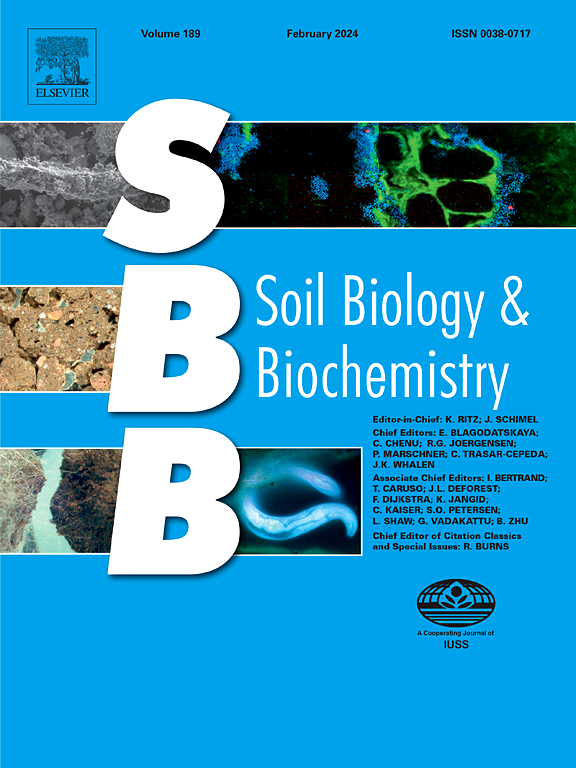北方森林土壤氮肥通过提高微生物坏死块的形成增加土壤碳库,但也改变了树木的次生代谢。
IF 10.3
1区 农林科学
Q1 SOIL SCIENCE
引用次数: 0
摘要
森林含有大量的全球碳(C)库,其中大部分储存在地下。森林土壤的氮肥可以增加生物量生产和土壤有机碳库,为减缓气候变化提供了一种战略。在这里,我们旨在通过化学、微生物学和温室气体通量的组合,在苏格兰松林上进行长期施肥实验,阐明氮添加导致土壤C增加的机制。结果表明,施氮增加了碳储量、微生物量、坏死块和细胞外酶活性,而温室气体产量没有显著增加。此外,施氮减少了一组植物次生代谢产物单宁的产生。这些深刻的变化是在土壤的有机层中观察到的,而在矿物土壤中的差异则不太明显。在机制上,氮肥通过增加凋落物输入和增加根C向土壤微生物的转移来增加C储量,增加真菌生物量和进一步的坏死块,并在土壤中得到稳定。我们的研究支持这样一种观点,即在持久性碳池中增加微生物坏死块的管理策略可能导致碳稳定性的提高,尽管应该谨慎对待植物代谢的潜在变化。本文章由计算机程序翻译,如有差异,请以英文原文为准。
Nitrogen fertilisation of boreal forest soil increases soil carbon pool through elevated microbial necromass formation but also modifies tree secondary metabolism
Forests contain significant amounts of the global carbon (C) pool with the major fraction stored belowground. Nitrogen (N) fertilisation of forest soils may increase biomass production and soil organic C pools, providing a strategy for climate change mitigation.
Here we aimed to elucidate the mechanisms behind the increase in soil C due to N addition using a long–term fertilisation experiment on a Scots pine stand with a combination of chemistry, microbiology and greenhouse gas fluxes.
Our results showed that N fertilisation increased C stocks, microbial biomass, necromass and the activity of extracellular enzymes, with no significant increase in greenhouse gas production. Moreover, N fertilisation decreased the production of a group of plant secondary metabolites, tannins. These profound changes were observed in the organic layer of the soil, and differences in mineral soil were less detectable.
Mechanistically, N fertilisation increased the C stock via elevated litter input and higher transfer of root C to soil microorganisms increasing fungal biomass and further necromass, which was stabilised in the soil. Our study supports the view that management strategies to increase microbial necromass in persistent C pools could lead to elevated C stabilization, though caution should be taken regarding potential changes in plant metabolism.
求助全文
通过发布文献求助,成功后即可免费获取论文全文。
去求助
来源期刊

Soil Biology & Biochemistry
农林科学-土壤科学
CiteScore
16.90
自引率
9.30%
发文量
312
审稿时长
49 days
期刊介绍:
Soil Biology & Biochemistry publishes original research articles of international significance focusing on biological processes in soil and their applications to soil and environmental quality. Major topics include the ecology and biochemical processes of soil organisms, their effects on the environment, and interactions with plants. The journal also welcomes state-of-the-art reviews and discussions on contemporary research in soil biology and biochemistry.
 求助内容:
求助内容: 应助结果提醒方式:
应助结果提醒方式:


